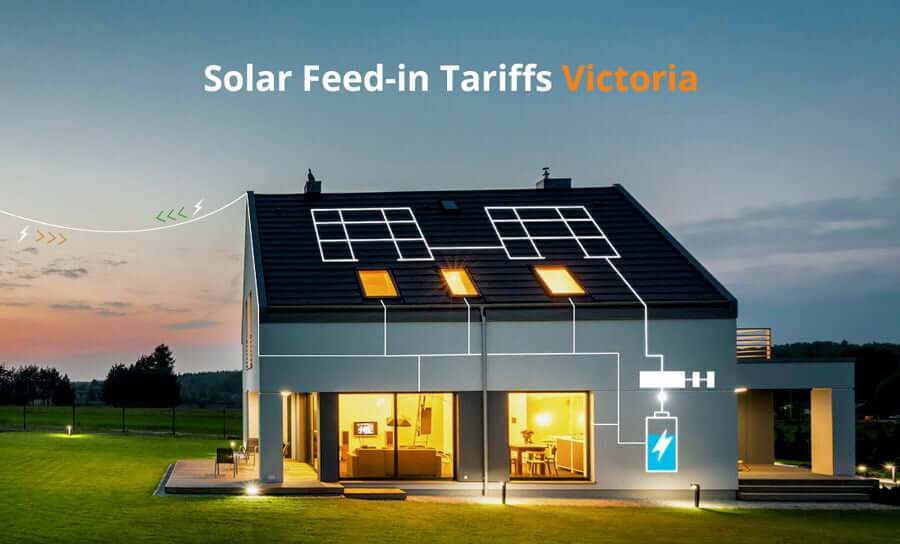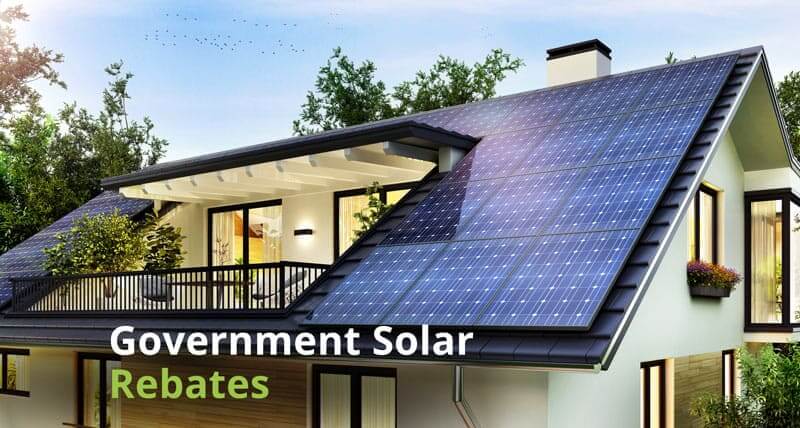Home Feed-In Tariffs Victoria Solar Feed-in Tariffs
Top Victorian Solar Feedin Tariffs (VIC)

The essence of it: We examine the solar buyback rates in Victoria
Our top 3 picks
| Max. FiT | Min. FiT | Category | |
|---|---|---|---|
 | 14c | 20c | Best overall |
| 13.5c | 13.5c | Best runner up | |
| 19.5c | 22.5c | Best large systems |
Finding the best solar feed-in tariff in Victoria is just as good as the savings you will get from the solar panels. In fact, it will increase your payback period up to 30% with the right plan.
Luckily, there are several electricity companies in Victoria and each of them offers very attractive tariffs.
Table of Contents
ToggleBest overall FiT in Victoria

| Min FiT | Max FiT |
| 14c | 20c |
Why we like Origin?
Origin have the highest minimum feed-in tariff rate going around. Three are lots of retailers that brag high max Fit’s, but they normally require a much larger system which the standard Australia house does not have installed.
Origin is one of the leading electricity companies in Victoria and also happens to offer some of the most attractive feed-in tariffs for its customers. At 14c/Kwh, Origin’s rate is several cents per kWh above the competition.
Here are some estimates showing how much you could gain from Origin’s generous average feed-in tariff in Victoria assuming you had a system capable of at least 5kwh surplus per day:
At 17c/Kwh- you get $8.5 in feed-in tariff credit with Origin on a given day.

This adds to about $255 savings a month and about $3000 in a year. Given the average annual power bills in Victoria, this amount could easily save you up to or more than 85% of the money you could have spent on electricity in a given year.
Origin energy outlines the following conditions for Victorian homeowners who want to get their feed-in tariffs from Origin:
- The feed-in tariff is open to Victorians who have installed a solar PV system equal to or less than 100Kw.
- The solar PV system must be connected to the grid and have proof of consent with a certificate of electrical safety.
- The customer must sign up on the Origin feed-in tariff website and agree on terms and conditions.
Best runner up FiT in Victoria
| Min FiT | Max FiT |
| 13.5c | 13.5c |
Why we like momentum energy?
Momentum energy have one of highest minimum feed-in tariff rate going. Three are lots of retailers that brag high max Fit’s but they normally require a much larger system which the standard Australia house does not have installed.
You may think they the difference between 10c and 13.5 cents for a feed-in tariff, but we are talking a 35% increase in revenue generated by your solar system. This will significantly affect your power bill on a monthly, quarterly and annual basis.
Momentum Energy company history
Founded in 2002 as a small energy and gas supplier, Momentum is not owned by Hydo Tasmania, one of Australia’s largest renewable energy produces. Every year they produce 9000 gigawatts which is enough to power 900,000 Aussie homes.
Best Max Fit’s for large systems in VIC
| 5kW FiT | Max FiT |
| 19.5c | 22.5c |
Why we like momentum energy?
Momentum energy have one of highest minimum feed-in tariff rate going. Three are lots of retailers that brag high max Fit’s but they normally require a much larger system which the standard Australia house does not have installed.
You may think they the difference between 10c and 13.5 cents for a feed-in tariff, but we are talking a 35% increase in revenue generated by your solar system. This will significantly affect your power bill on a monthly, quarterly and annual basis.
All Feed-In Tariffs in Victoria
The best feed-In tariffs in Victoria will depend on your personal preference. Remember you also have to buy power from the company, so if they are selling it at twice as much as they are buying it from you, then it might not work out that well. You will need to do your due diligence. We can only point out the best feed-in tariffs for your state.
The table below shows a more detailed comparison of feed-in tariffs offered by different electricity companies and retailers in Victoria today.
| Electricity Retailer | Min FiT | Contact Details |
|---|---|---|
| 12.0c | Go to site |
|
| 11.0c | Go to site |
|
| 7.0c | Go to site |
|
| 7.0c | Go to site |
|
| 7.0c | Go to site |
|
| 5.5c | Go to site |
|
| 5.4c | Go to site |
|
| 5.4c | Go to site |
|
| 5.2c | Go to site |
|
| 5.2c | Go to site |
|
| 5.0c | Go to site |
|
| 5.0c | Go to site |
|
| 4.9c | Go to site |
|
| 4.9c | Go to site |
|
| 4.9c | Go to site |
|
| 4.9c | Go to site |
|
| 4.9c | Go to site |
|
 | 4.9c | Go to site |
 | 4.9c | Go to site |
| 4.9c | Go to site |
|
| 4.9c | Go to site |
|
| 3.9c | Go to site |
*These feed-in tariffs are captured as they are by the time of publishing this guide. However, electricity companies are at liberty to change their feed-in tariffs from time to time. Ensure that you confirm the current FiT rate from your retailer at the time you are signing a contract. Also, see if it’s still competitive and above or equal to the Victorian Essential Services Commission’s minimum feed-in tariff.
How Does the Feed-in Tariff Work in Victoria?
In short, the solar feed-in tariff acts like a virtual battery where you feed-in excess power produced by your solar system throughout the day. Utility companies will give you a credit for this power. They then sell power back to you at night.
Suppose you have installed a standard grid-connected 6,600watt (6.6Kw) solar PV system on your residential building in Melbourne. Daily output estimates are drawn from historical data and other sources indicate that a standard 6Kw solar PV installation in Melbourne would produce an average of 21.95Kwh per day.
Because most homeowners use only 30% of their energy through the day and 70% at night, you will use 6.5kW through the day but will need to store the remaining 15.45 kWh for use later that night. Without solar battery storage, the solar energy not used will go to waste.

Feed-in tariffs in Victoria are usually given as credits which you spend at night. Because night is peak power and more expensive and you give them power in off peak, there is a difference in the amount they pay for power and the amount they charge you.
This all means the typical home will reduce their power bill by 85-90%. This also means that you don’t need to invest in expensive battery storage in order to utilize all the energy produced by your solar PV system, hence shortening your solar PV payback periods as well.
There are several electricity companies offering generous feed-in tariffs to their customers in Victoria. That said, it’s advisable to utilize as much of the solar energy your produce from your PV system during the day even before thinking about sending it to the grid.
Difference between gross and net feed-in tariffs
Two types of feed-in tariffs offered by Victorian power companies.: gross feed-in tariffs and net feed-in tariffs. This is important and will make a difference to the bottom line of your bill.
Gross Feed-in tariffs
This is where all power produced is fed into the grid. Then you draw what is required back from the grid. I advise against this option as you will inevitability pay more as power companies mark up the price on power as the feed it back to you.
Net feed-in tariffs
This is where you are you use power generate by your solar system directly and only feed excess power to the grid. This is a better option as you are using the free power you produce and only using the surplus for feed-in tariffs.
All companies offer different rates and packages for their feed-in tariffs but are guided by a standard minimum rate set by the Victorian Essential Services Commission. This means that companies are essentially discouraged from offering feed-in tariff rates that are lower than the commission’s minimum feed-in tariff. For instance, the commission’s 2020/201 minimum FIT for peak hours was set at $12.5c. kWh by the time of publishing this guide.
FAQs
Yes, you are not only eligible for the federal STC-based solar rebate but also the state government solar rebates and battery rebates. Solar rebates based on STCs could be as high as $5000 while the state rebate was valued at $2225 when we published this guide. Both rebates and other incentives could cut your initial investment in a solar PV system significantly (over 50%).
Feed-in tariffs will change over the year depending on prevailing conditions in the energy market and other retailer dynamics. For instance, Origin Energy recently revised its feed-in tariff for all customers covering the period between June 2020 to June 2021. Some retailers may even have different feed-in tariffs for different months of the year.
Is it worth it hunting around for the best feed-in tariff or even connecting your solar PV system to the grid?
Well, this depends on how much energy your solar PV system can produce at different times of the day and how much you use. If you can produce enough energy to consume and have a surplus, then you might benefit from the generous feed-in tariffs on offer.
This also depends on the amount of sun you get in your location and for how long. Do you live in a part of Victoria with a decent amount of sunlight for several months? If so, the likelihood of producing surplus solar energy and exporting it to the grid is quite high. The opposite is also true for those with long winters and negligible sunlight for the better part of the year.
Some retailers may lock you into a contract in order to accept your exported energy. However, as with most contracts in Victoria, you are allowed to terminate a contract whenever you want subject to conditions agreed upon with your electricity retailer. Always take time to study a feed-in and supply contract before you sign. Some retailers have attractive solar feed-in tariffs but expensive supply rates!
Table of Contents
Toggle




